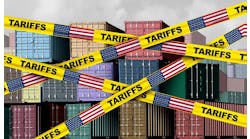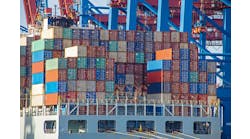While the supply chain crisis that followed the pandemic affected nearly every industry, the major struggles have largely been overcome. Representatives from four automation suppliers—Balluff, Delta Motion, DigiKey and Festo—discuss current supply chain trends, as well as pandemic challenges, continued microchip woes, lessons learned from the crisis and expectations for the future industrial automation supply chain.
Pandemic-related supply chain challenges
1. Missing components and slower transportation led to global shortages.
“The pandemic impacted all businesses in some way. For Balluff, as a sensor and automation company, the missing component availability caused by global material shortages, as well as slower transportation routing causing delays in the material supply, resulted in slower-than-typical order fulfillment for a portion of our portfolio,” says Frank Nonnenmann, managing director and head of supply chain at Balluff.
2. Long lead times ultimately leads to increased labor costs.
“At Delta Motion, we experienced long lead times on many items—often listed as 99 weeks, which was probably the largest number the component suppliers’ systems supported. We employed a number of strategies to combat this that resulted in increased and labor costs. These efforts were critical to maintaining Delta’s reputation for excellent customer support, which includes two-week lead times,” says Steve Nylund, CEO of Delta Motion. “We added weekly planning meetings, authorized overtime, qualified new suppliers and allocated engineering resources to meet this challenge, including the vast majority of our electrical engineering resources for more than one year. In some cases, we were able to buy components from alternative sources, paying as much as $195 for $7 parts. In other cases, we had to redesign printed circuit boards (PCBs) to allow use of a replacement part. Through a tremendous effort, we were able to keep our normal lead time of two weeks for most products, extending to eight weeks maximum for a short time on a few items.”
3. The more advanced the product, the more it was affected.
“Navigating supply-chain issues during the pandemic was difficult for everyone. For our business, as a stocking distributor, we were in a better position than others to stay the course,” says Eric Halvorson, partnership marketing manager II, strategic programs at DigiKey. “From the industrial automation side of the business, the most affected products were programmable logic controllers (PLCs), programmable automation controllers (PACs), industrial PCs (IPCs), human-machine interfaces (HMIs), drives and Ethernet switches. Really, the more advanced the product, the harder it was to get into inventory. In many cases, when we would receive product in, it went right back out the door the same day to fill a back order.”
4. A buildup of inventory eventually led to project delays.
“Customers were pushing back projects, and there were two main causes for that. In most cases, the story that we got was that their floor was just full. They had a lot of orders to go out the door, but they had a bunch of mostly completed machines just waiting for some part from some vendor before they could ship it, and so they simply couldn’t start new projects,” says Sean O’Grady, sales operations director at Festo. “There are cases also where their customers asked them to delay the project. We didn’t lose customers. The supply chain just slowed everything down to where everyone was sitting on inventory.”
More effects from the microchip shortage and other supply chain challenges
1. Not enough chips
“Starting with the pandemic, we began experiencing an increase in the lead times for microelectronic components and a shift to an allocation market. This caused an increase of our order books because we were not able to serve market demands. Production capacities were installed but not enough components could be produced to meet all the market demands,” says Nonnenmann of Balluff.
2. Advanced technologies stalled
“With the semiconductor shortage worsening and long lead times due to shipping and shortages on ports of entry, we started to see a deepening problem, specifically with advanced products such as PLCs, HMIs and drives,” says Halvorson of DigiKey.
3. Pushed new-generation products
“A large and increasing percentage of Festo’s products are comprised of semiconductors. Luckily our biggest challenges seemed to come from products that were relatively late in their lifecycles,” says O’Grady of Festo.
4. Inaccurate lead times
“As inventories declined through our manufacturers and lead times went out, one of the biggest challenges we encountered were inaccurate stated lead times. When a manufacturer states a lead time, you plan for your inventory-level management around that; when that date isn’t met, we’re letting the customer down, and that’s not good for anyone,” Halvorson says.
5. Shortage of custom plastics compounds
“We also had delays in custom plastic compounds for molded parts—to combat that, we made a few parts in a different color for a short period of time,” says Nylund of Delta Motion.
6. Wavering customer demand
“The timing and quantity of demand from our customers would shift more dramatically than normal,” says Andrew Sizemore, supply chain director at Festo.
Good news for the current industrial automation supply chain
With supply-chain relief coming in 2024, companies are experiencing higher inventories. They are able to focus on new product development, with better access to advanced technologies and new, more advanced product versions. Many have realized the value of a localized supply chain.
- “All the pandemic-related negative effects have been offset by regular business and stable processes,” says Nonnenmann of Balluff. “We are experiencing high inventories throughout the industries that is slowing down demand at the suppliers, but this should recover in 2024.”
- “The component lead times have largely been resolved. This has taken pressure off our purchasing personnel and freed up our engineers to focus on new product development without the distraction of dealing with shortages. Since our products are just one part of a system, a general improvement in availability boosts our sales, as well,” says Nylund of Delta Motion.
- “The supply chain has really improved in the area of semiconductors for us. While it’s still not to where it was, it is getting pretty close. This has meant a lot of those more advanced products have become much easier to get. We are finally seeing new product introductions and our inventory levels on the mend,” says Halvorson of DigiKey.
- “We’ve accelerated the localization of our supply base and have established new relationships with new vendors. We’ve strengthened relationships with customers in a couple of ways,” says O’Grady of Festo.
Stronger for it: lessons learned from supply-chain struggles
Demand for industrial automation products has only increased since the pandemic, so those that weathered the storm and realigned, reconfigured and rethought their businesses and supply-chain practices are in good shape for the future. More strategic planning, better communication and product redesigns largely stayed the supply-chain issues for industrial automation, and the reinvigorated sense of adaptability has companies feeling better about the future. The following are some of the important lessons that vendors and suppliers learned and how it changed business for the better.
Product redesign
“We worked in close cooperation with our suppliers to ensure the best possible supply of components. In addition, we initiated product redesigns to switch to components that are not in allocation. We are making strategic decisions on future demands and long-term orders placed for better planning,” says Nonnenmann of Balluff. “Supply-chain issues led to an increased intensity of communication, which resulted in a significant contribution to a better understanding of the current situation in both directions and the common understanding of the next steps.”
Manufacturer relationships
“There is also a certain level of brand loyalty for customers; it is important that we try to meet their expectations and make their user experience the best we can. One of the ways to do that is through brand diversity. It is also important to note that no single manufacturer makes it all. They each have their strengths and their weaknesses,” says Halvorson of DigiKey. “To make sure we meet the needs of the customers, we develop partnerships with organizations such as A3, and we build relationships with manufacturers. As we continue to build these relationships, you begin to create a credibility for yourself with customers, organizations and manufacturers alike.”
Strong inventory
“We hope that these conditions won’t return. However, our longstanding practice at Delta Motion has been to keep large amounts of components in stock and modules in process. This helped with dealing with the COVID-fueled issues and will help with future disruptions,” says Nylund of Delta Motion.
What will the future industrial supply chain look like?
Many suppliers were already localizing supply chains before the pandemic, and more will likely follow suit. Balluff recently built a new production facility in Aguascalientes, Mexico, to regionalize production for the Americas. Festo’s facility in Mason, Ohio, has transitioned from warehouse to factory production. The following are more on the ways industrial automation manufacturers are preparing their supply chains for the future and what they expect.
Regional production footprint
“An increase of the regional share of our supplier base and the change to a more regional production footprint will reduce the risk of material supply disruption moving forward. This will be achieved by the expansion to a multi-source supplier base and the capability of multi-source production capabilities,” says Nonnenmann of Balluff.
Changing workforce
“Pandemics, geopolitical events, wars and natural disasters will always be a threat to supply chain. How manufacturers navigate these events in the future will determine their viability in this new post-pandemic world. One of the changes we saw during the pandemic was that the workforce would change greatly. All over the world, manufacturers now face a workforce-shortage epidemic. That doesn’t mean the demand for products has gone down, nor have customer expectations in quality and now the environmental impact these products have on the climate, both during manufacturing and after. This has had a major impact on how manufacturers must now do business. Higher expectations, higher demand, smaller workforce,” says Halvorson of DigiKey. “Looking to the future, I believe we will see more multi-sourcing of raw materials and components. I believe we will see more manufacturing taking hold in places like Eastern Europe, the Americas and India to name a few.”
More machining and more local raw materials
“When this building in Mason, Ohio, first opened, what Festo calls a regional supply center, mostly a warehouse, and then, we would do final assembly of configurable products. The final assembly of configurable products is really a big part of our business. But we’re transitioning into what Festo calls a global production center (GPC), which is an actual factory,” says O’Grady of Festo. “It used to be that we buy all the finished components from our various other global factories and bolt them together or cut them to length and then bolt them together. Now, we’re doing a lot more machining, and that requires us to bring in a lot more local raw material suppliers.”





